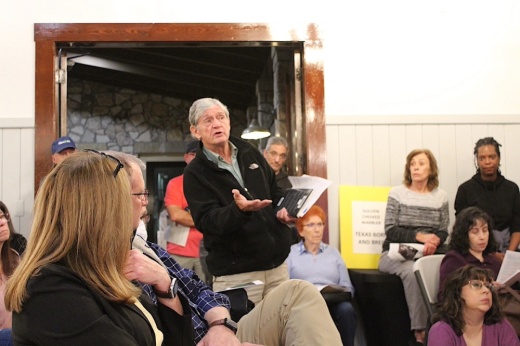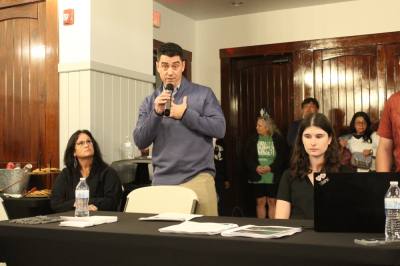The background
More than 50 residents of Cibolo Canyons, a neighborhood just north of San Antonio city limits, gathered in their community amenities center Feb. 1 to meet representatives with Starwood Land, the original Cibolo Canyons developer.
Starwood Land in January informed U.S. Fish and Wildlife Service of a proposed amendment to the company’s Incidental Take Permit request to acquire a nearby unoccupied 30-acre tract of land preserved for the golden-cheeked warbler, an endangered species.
In exchange, the Florida-based developer proposes adding 144 acres of land identified for potential development toward the bird’s habitat preserve.
John Brian, Starwood Land’s East Region president, told the gathering of Cibolo Canyons residents that the company acknowledged the concerns that community members have expressed about the developer’s request.
Brian said the company must do what is in its best interest, business-wise, as their current proposal calls for building 107 single-family homes in the general area.
Brian also said his company wants to address residents worried about how potential future development could affect the warbler’s habitat, the surrounding Edwards Aquifer recharge area, and local traffic and drainage patterns.
The 30-acre tract lies within the Cibolo Canyons Conservation Easement, and is sandwiched between Cibolo Canyons, Indian Springs subdivision and the the TPC San Antonio golf course.
Dig deeper
Valerie Collins, a vice president at local firm Pape-Dawson Engineers, which was tasked to survey Starwood Land’s targeted properties, said the warbler once bred and thrived around the 30-acre tract, but has since been driven away by surrounding development.
Collins said the warbler has been spotted in recent years around the 144-acre parcel, which sits on the eastern edge of TPC San Antonio.
Brian said his company hopes to develop single-family homes on either tract, but that it would be easier to do on the 30-acre tract because it is located closer to existing adjacent infrastructure, whereas the 144-acre parcel would be comparably more difficult to develop.
“We’ve had conversations with the Bexar Audubon Society and The Nature Conservancy. We’re looking for a third option,” Brian told the crowd. “But at this point, developing the 30 acres or developing the 144 acres is what we’re talking about.”
A third option, Brian said, could be to sell the land to the federal government if the latter is inclined to offer an acceptable price.
“If that's a viable option for us, I can stand up here in all honesty and say it's an option that we would probably take,” Brian said.
Collins said her company compiled warbler observational data and provided it to Starwood Land. She said the developer proposes providing the larger tract—144 acres—to help preserve what remains viable warbler habitat east of TPC San Antonio.
“Rather than having all of this development right here [in 144 acres], it is better to preserve that for the warblers so that [warblers leaving] doesn't happen like what happened [in the 30-acre area],” Collins said.
What they’re saying
But many local environmentalists and Cibolo Canyons residents said they are unconvinced and unmoved by Starwood Land’s proposal.
Bexar Audubon Society President Britt Coleman said the 144 acres are not ideal for warbler habitat. He also said if the federal government approves a land swap, such a decision could set a precedent where for the maintenance of conservation easements, which he added are designed to preserve an area, as is, for perpetuity.
Some residents said Starwood Land has failed to follow up on previously stated promises to develop more community resources for Cibolo Canyons residents. Resident Alan Montemayor said he and his neighbors will continue to oppose Starwood Land’s plans.
“You’ve represented many things that haven’t materialized, like another amenities center,” resident Alan Montemayor said. “This is not going to end here.”
Other residents voiced worry that additional development near them could not only threaten the ecosystem, but it could exacerbate existing traffic, impervious cover and drainage issues in the immediate area.
“This is our water supply, and we don’t realize at this point how incredibly precious it is,” resident Diane Temple said.
What’s next?
The open comment period regarding Starwood Land’s ITP request ends Feb. 16. Coleman and neighborhood leaders urged residents to post their comments and questions on the Fish and Wildlife Service website.
According to Fish and Wildlife Service, a decision on the ITP proposal will be made at least 30 days after the end of the public comment process.
After the meeting, Brian said his company would keep communicating with Cibolo Canyons residents about ITP process.
“We’re optimistic that residents will come to a better understanding of our proposal seeks to minimize impact to the area’s natural landscape and the Edwards Aquifer, and also provides a solution to enlarge the area of protected land that the golden-cheeked warbler can inhabit,” Brian said.







